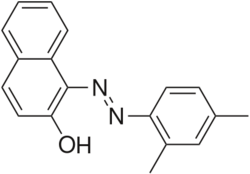Sudan Ii
 From Handwiki
From Handwiki 
| |
| Names | |
|---|---|
| IUPAC name
1-(2,4-Dimethylphenylazo)-2-naphthol
| |
| Other names
see text
| |
| Identifiers | |
CAS Number
|
|
3D model (JSmol)
|
|
| ChemSpider |
|
| KEGG |
|
PubChem CID
|
|
| UNII |
|
InChI
| |
SMILES
| |
| Properties | |
Chemical formula
|
C18H16N2O |
| Molar mass | 276.339 g·mol−1 |
| Melting point | 156 to 158 °C (313 to 316 °F; 429 to 431 K) |
Except where otherwise noted, data are given for materials in their standard state (at 25 °C [77 °F], 100 kPa). | |
| Infobox references | |
Tracking categories (test):
- SizeSet
Sudan II (Solvent Orange 7, C.I. 12140, C18H16N2O)[1] is a lysochrome (fat-soluble dye) azo dye used for staining of triglycerides in frozen sections, and some protein bound lipids and lipoproteins on paraffin sections. It has the appearance of red powder with melting point 156–158 °C and maximum absorption at 493(420) nm.[1]
Uses
In industry, it is used to color nonpolar substances like oils, fats, waxes, greases, various hydrocarbon products, and acrylic emulsions.[2]
It was used as food dye under the designation FD&C Red 32 in the US until the FDA banned its use in food in 1956 due to toxicity.[3]
References
- ↑ 1.0 1.1 "Substance Name: C.I. Solvent Orange 7". ChemIDplus, Toxnet Database. https://chem.nlm.nih.gov/chemidplus/rn/3118-97-6. Retrieved 15 October 2016.
- ↑ "HSDB: C.I. Solvent Orange 7. CASRN: 3118-97-6". Toxnet. https://toxnet.nlm.nih.gov/cgi-bin/sis/search2/r?dbs+hsdb:@term+@DOCNO+6365. Retrieved 15 October 2016.[|permanent dead link|dead link}}]
- ↑ Deshpande, S.S., ed. (2002), "8.5.3 Toxicological Characteristics of Colorants Subject to Certification", Handbook of Food Toxicology, Food Science and Technology, CRC Press, p. 234, ISBN 9780824707606, https://books.google.com/books?id=Mk-IdNTTJB0C&pg=PA234
 |
Categories: [Azo dyes] [2-Naphthols] [Alkyl-substituted benzenes]
↧ Download as ZWI file | Last modified: 09/18/2024 10:11:23 | 23 views
☰ Source: https://handwiki.org/wiki/Chemistry:Sudan_II | License: CC BY-SA 3.0
✘
ZWI is not signed. [what is this?]

 KSF
KSF